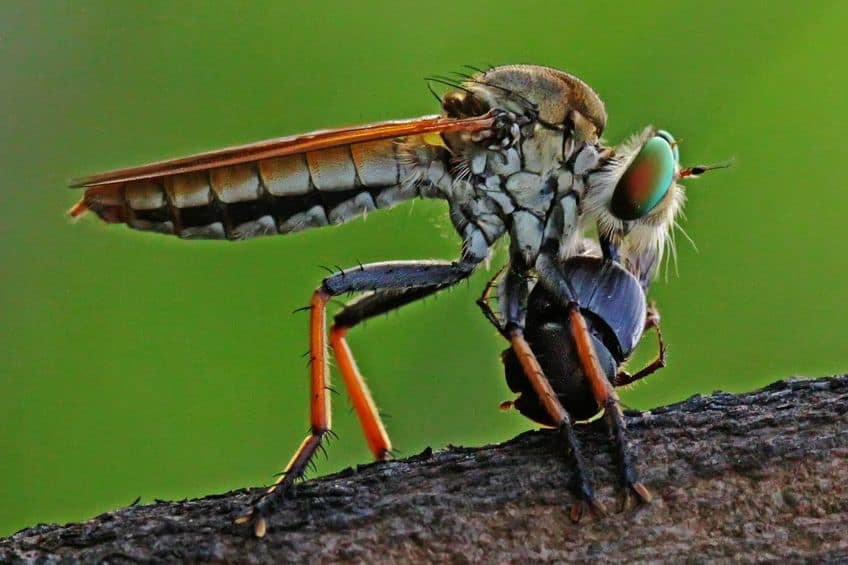What Is A Robber Fly?
Robber flies also referred to as assassin flies are part of the Asilidae family and the Diptera order, commonly known as true flies. Robust bristly flies, they are equipped with a short and stout proboscis that encloses a sharp sucking hypopharynx.
You can identify robber flies by their spiny stout legs and their distinctive “mustached” face, which is referred to as their mystax. However, this is where the uniformity ends, as some species of robber flies have a long and slender abdomen that tapers down to a point. In contrast, others have a very rounded and stocky abdomen that looks similar to a bee.
Robber flies can grow up to 1.5 inches in length, large enough to outsize and consume most other insects that live in their habitats.
Where Are Robber Flies Found?
You may spot robber flies in any region except for Antarctica. Generally speaking, robber flies inhabit open and sunny areas with dry arid climates. Some species of robber flies have adapted to cold tundra environments and have even been spotted at altitudes above 4000 meters. These predatory insects are often seen in parts of Arizona, including, but not limited to, Sedona and Phoenix.
Some varieties of robber flies live in forested ecosystems, and while they are rarer in these regions, they will most often be found in meadows and other open spaces within these areas.

How Did Robber Flies Get Their Name?
Robber flies got their name by the way they aggressively hunt other insects. Most of the time, robber flies lie in wait and ambush other insects mid-flight or when they have stopped to feed. Their entire diet is based almost exclusively on consuming other bugs, making them excellent at controlling the number of pest insects.
Do Robber Flies Sting or Bite?
Robber flies are harmless to people and do not bite or sting, but they are deadly predators of other insects.
Robber flies have a short powerful proboscis that they use to stab their prey. In doing so, they inject their victims with saliva that contains neurotoxic and proteolytic enzymes, paralyzing their prey very rapidly. The second step in their predatory routine is to suck their prey’s liquified insides through their proboscis, leaving the desiccated corpse behind.
What Do Robber Flies Eat?
Robber flies eat an enormous variety of prey, which includes but is not limited to the following:
- Other kinds of flies
- Many types of beetles
- Butterflies and moths
- Various bees
- Ants
- Dragonflies and damselflies
- Ichneumon wasps
- Grasshoppers
- Some spiders
One of the fascinating aspects of robber flies, making them such effective predators, is that they are willing to attack and feed on any prey regardless of their defense mechanisms. Many insects have repugnatorial chemicals that make them uninteresting to potential predators. However, robber flies have no issue feeding on any insects that possess these defensive capabilities.
Do Robber Flies Make Nests?
Robber flies do not make nests. Different subspecies of robber flies lay their eggs in different locations. Those with undifferentiated ovipositors release eggs randomly. However, other variations of robber flies have a different kind of specialized ovipositor that allows them to lay eggs in the soil, sand, or inside plant cavities.
Do Robber Flies Pollinate?
Due to their extended abdomen and ovipositor for laying eggs, many people mistakenly believe that robber flies pollinate various types of plants in a similar way to bees. However, robber flies do not pollinate any kind of vegetation as they do not consume nectar. They do, however, sometimes consume pollinating insects including bees.
What Preys on Robber Flies?
Robber flies are towards the top of the insect food chain, but they have many predators. Some of the more common predators that robber flies need to worry about include but are not limited to:
- Birds
- Bats
- Lizards
- Frogs and toads
- Large spiders
Since robber flies occupy many different regions worldwide, and with many subspecies within their classification, the predators that eat these insects are very wide-ranging and heavily dependent on habitat.
Friends or Foes?
Despite their somewhat frightening appearance, if you spot robber flies in your garden or yard, take comfort in the fact that they are generally beneficial insects. While these predators may occasionally consume other beneficial insects like bees or butterflies, they more than overcome that by the number of grubs, grasshoppers, and other insects they prey upon that can be harmful to your foliage.
